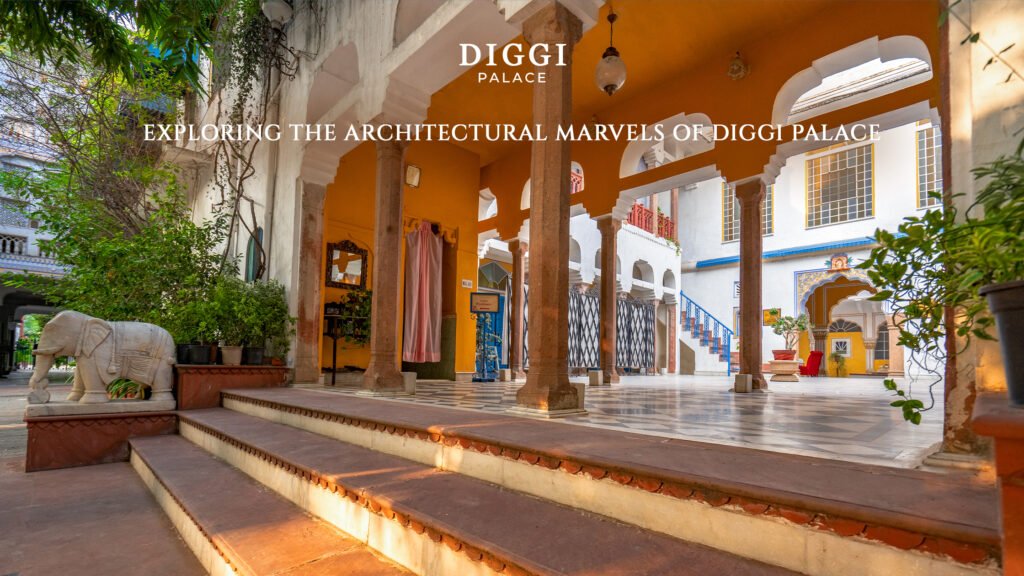
The Diggi palace is a living monument built in the 1860s by the Diggi family of Rajputs as their city residence. The palace showcases the integration of Rajput, Mughal and British architectural ideas. Walking through the courtyards and gateways of the property feels like taking a walk through history and living through the stories that were created in these places. Bold symmetry, carved jharokhas, intricately designed chhatris are a symbol of Rajput architecture whereas lush green gardens and frescoes portray elegance which is a symbol of Mughal architecture and the high ceilings, ironwork detailing and verandas are a symbol of British architecture. The Diggi Palace Hotel is an architectural masterpiece showcasing the union of three different styles of structure, giving the guests a full blown heritage experience. In this blog, we will learn about the architecture and its features.
Table of contents
- Historical Architectural Influences
- Key Architectural Features
- Materials and Craftsmanship
- Preservation Efforts
- Visiting Tips for Architecture Lovers
- Conclusion
Historical Architectural Influences
The origins of the architectural style of the Diggi Palace come from Rajputana and Mughal traditions with touches of elements from the British colonial era. This jewel of architecture was built by Rajputs, which explains the strength, symmetry, and intricate artistry in the ornately designed jharokhas, chhatris, and stone latticework. These architectural elements were not only for aesthetic purposes but also had practical use for ventilation during the hot weather of the arid land of Rajasthan.
Whereas the grandeur and elegance of arched doorways, lush green gardens, and delicate frescoes, the courtyards, and the garden layouts portray the Mughal influence on the architecture of the palace. Although the European elements such as the open verandas, high ceilings, and iron detailing all around the property showcase the influence of the British colonial era. All these elements influenced by the periods of the three time periods make the Diggi Palace a living museum of architectural heritage.
Key Architectural Features
The entirety of the Diggi Palace Hotel exhibits traditional Rajasthani architecture and takes us back to its historical value that it signifies. The vibrant colors of the frescoes and the ornate patterns on the wall paintings signify the symbols of royalty and mythology, which help you to understand the cultural roots of Rajasthan. The jharokhas, overhanging windows, were not only designed for their aesthetics but for practical purposes too. They were used for ventilation in the hot summers, and the females of the royal family used them to get a peek of the outside of the home, maintaining their privacy.
Whereas the grand courtyards filled the purpose of hosting large gatherings and celebrating festivals. The courtyards consisted of greenery and flowers with intricately designed water fountains, which increased the aesthetic value of these courtyards.
Materials and Craftsmanship
The establishment of the ornate Diggi Palace was done with the use of locally sourced materials such as sandstone, marble, and lime mortar and the skills of local artisans and craftsmen. The blend of Rajputana and Mughal architecture and their intricate designs tell us about the highly skilled craftsmen and artisans of ancient times that were behind the creation of this architectural masterpiece. Durbar Hall, with its 12-foot-long stone slab roof, amazing frescoes, and jharokhas, is the living proof of the expertise of the local craftsmen.
The hospitality organizes various workshops and exhibitions in order to promote the local Rajasthani crafts of Jaipur. These exhibitions showcase art and craft such as miniature painting, indigo dyeing, block printing, gota patti, and leather footwear in front of global guests. The palace has an important role in preserving and promoting the culture and heritage of Rajasthan.
Preservation Efforts
The transformation of the royal residence of the Diggi family to a heritage palace hotel required a significant amount of restoration and maintenance of the palace to provide an experience of heritage with modern comfort. The maintenance of the palace has been done by its owners and managers, the Diggi family, and to maintain the authenticity of the palace, the preservation of the palace has been done by traditional building techniques and materials such as sandstone and lime mortar.
The conservation of heritage while upgrading the palace to meet the checklists of modern hospitality is quite a challenge and financially draining, as the cost of hiring craftsmen with the high skills to replicate the intricate designs is hard and incurs high costs. Yet, the Diggi Palace Hotel Jaipur is a great example of sustainable heritage conservation.
Visiting Tips for Architecture Lovers
Diggi Palace in itself is quite a marvel, and it deserves to be explored in depth. The palace is a haven for history buffs and architecture admirers. Guided tours of the palace will help to get into the richness of the architectural style and the ancestral heritage it carries with it. Tours from the professional guides or members of the Diggi Family will help you understand the reason and story behind each and every carving of the intricately designed jharokhas, arches, courtyards, and frescoes.
With the fusion of Mughal and Rajput styles of architecture alongside the hint of elements from the British era, the palace hotel makes for a great spot for architectural photography. The best time to visit the Heritage Palace Hotel is during the winter season, as the weather at that time is quite pleasant and makes for the perfect time to explore the palace in all its glory.
Conclusion
Exploring the Diggi Palace hotel in Jaipur feels like taking a walk through history and listening to the story each element is narrating through its carvings and symbols. The palace is a great example of how three different styles of architecture—Rajput, Mughal, and British—created a palace carrying cultural heritage.
